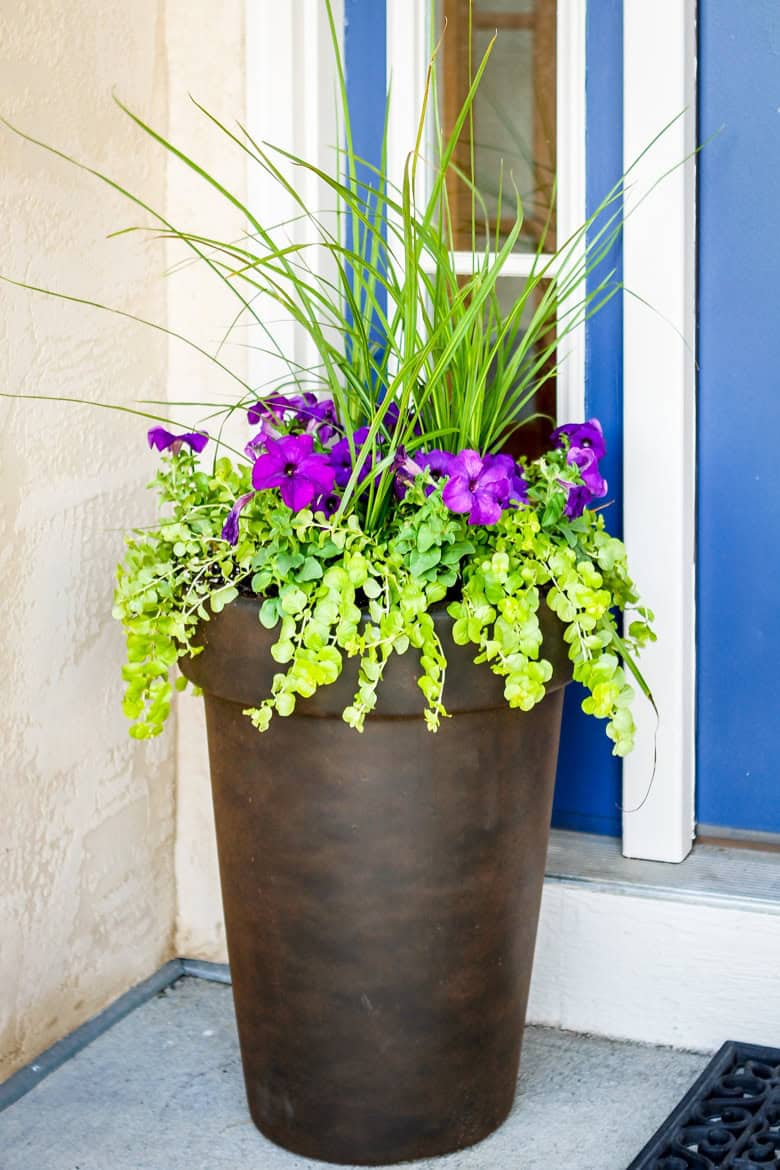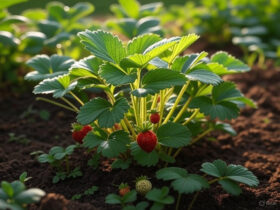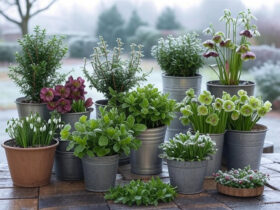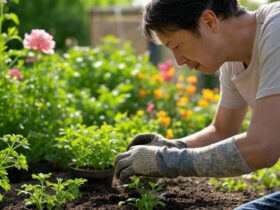Planting a flower in a flower pot is easy and rewarding. You can enjoy beautiful blooms right at home.
Now we talk about How to Plant a Flower in a Flower Pot. In today’s busy world, many people find joy in simple gardening tasks. Planting flowers in pots is perfect for beginners and those with limited space. Potted flowers can brighten any room, balcony, or garden. You only need a few supplies and a bit of time to get started.
Plus, it’s a great way to bring nature closer to you. This guide will help you plant a flower in a pot, ensuring it grows healthy and vibrant. Ready to begin your gardening journey? Let’s dive into the steps to create your own mini garden.
Choosing The Right Pot
Planting a flower in a flower pot can be a rewarding experience. Choosing the right pot is crucial for the health and growth of your plants. A well-chosen pot ensures that the flowers have enough space, proper drainage, and a suitable environment to thrive. Let’s delve into the factors that make a pot perfect for your flower planting needs.
Size Matters
The size of the pot plays a significant role in how to plant a flower pot successfully. A pot that is too small can restrict root growth, while a pot that is too large may retain too much water, causing root rot. Here are some key points to consider:
- Root Space: Ensure the pot provides adequate space for roots to expand.
- Plant Type: Different plants require different pot sizes. For example, small flowers like pansies need smaller pots, while larger plants like sunflowers need bigger pots.
- Growth Potential: Consider the plant’s growth potential. If it grows quickly, choose a larger pot.
Here’s a simple table to help you choose the right pot size based on plant type:
| Plant Type | Recommended Pot Size |
|---|---|
| Small Flowers (e.g., Pansies) | 6-8 inches |
| Medium Flowers (e.g., Marigolds) | 8-12 inches |
| Large Flowers (e.g., Sunflowers) | 12-18 inches |
Material Options
The material of the pot is another crucial factor in how to plant flowers in containers. Different materials offer various benefits and drawbacks. Here are some common options:
- Clay Pots: These pots are porous and allow air and water to pass through. They are great for plants that require good drainage but can dry out quickly.
- Plastic Pots: Lightweight and durable, plastic pots retain moisture well. They are ideal for plants that need consistent watering.
- Ceramic Pots: These pots are often glazed, making them non-porous. They retain moisture better than clay pots but are heavier.
- Metal Pots: Metal pots are stylish and durable but can heat up quickly, which may affect the plants.
Below is a table summarizing the pros and cons of each material:
| Material | Pros | Cons |
|---|---|---|
| Clay | Good drainage, breathable | Dries out quickly, heavy |
| Plastic | Lightweight, retains moisture | Less breathable, can look cheap |
| Ceramic | Retains moisture, attractive | Heavy, can be expensive |
| Metal | Durable, stylish | Heats up quickly, can rust |
Understanding the importance of pot size and material helps you learn how to plant flowers in containers effectively. Each choice impacts the health and beauty of your plants.
Table of Contents
Selecting The Perfect Flower
Planting flowers in a flower pot can add beauty to any space. Choosing the right flower is crucial for a thriving garden. Selecting the perfect flower involves considering several factors such as the type of flower and its sunlight requirements. This guide will help you make the best choice.
Annuals Vs Perennials
Understanding the difference between annuals and perennials is essential. Annuals complete their life cycle in one growing season. Perennials return year after year. Each type has its benefits and drawbacks.
- Annuals:
- Bloom all season long
- Variety of colors and shapes
- Require replanting every year
- Perennials:
- Come back every year
- Less maintenance
- Limited bloom period
Consider your gardening goals. Annuals are great for vibrant, seasonal displays. Perennials are ideal for long-term garden planning. Here’s a quick comparison:
| Feature | Annuals | Perennials |
|---|---|---|
| Bloom Duration | All season | Short period |
| Maintenance | High | Low |
| Replanting | Yearly | None |
This comparison will guide you on how to plant flowers in containers effectively.
Sunlight Requirements
Sunlight is crucial for flower health. Different flowers have varying sunlight needs. Knowing these requirements helps in how to plant flowers in a planter.
- Full Sun:
- Requires 6+ hours of direct sunlight daily
- Ideal for sun-loving plants like marigolds and petunias
- Partial Sun/Partial Shade:
- Needs 3-6 hours of sunlight
- Suitable for plants like begonias and impatiens
- Full Shade:
- Less than 3 hours of sunlight
- Best for shade-loving plants like ferns and hostas
Understanding sunlight needs ensures successful planting. Here are some examples:
| Sunlight Type | Flower Examples |
|---|---|
| Full Sun | Marigolds, Petunias |
| Partial Sun/Partial Shade | Begonias, Impatiens |
| Full Shade | Ferns, Hostas |
Choose flowers based on their sunlight requirements for how to plant flower containers. This ensures healthy and vibrant blooms.

Preparing The Potting Mix
Planting a flower in a flower pot can bring color and joy to any space. To ensure that your flowers thrive, preparing the potting mix is crucial. A well-prepared mix provides the right balance of nutrients, moisture, and air. Let’s dive into the key components of preparing the potting mix for your flower pot.
Soil Composition
The soil composition is the foundation of your flower pot’s success. Using the right mix ensures your flowers get the nutrients they need. Here are some important components to consider:
- Organic Matter: Includes peat moss, compost, or bark. It helps retain moisture and provides nutrients.
- Mineral Content: Sand, perlite, or vermiculite improve aeration and drainage.
- Nutrients: Fertilizers like nitrogen, phosphorus, and potassium support healthy growth.
Mixing these components correctly is key. A typical potting mix ratio might look like this:
| Component | Percentage |
|---|---|
| Organic Matter | 40% |
| Mineral Content | 30% |
| Nutrients | 30% |
This mix ensures your flowers have a balanced environment. Understanding how to plant a flower pot starts with good soil composition. This provides the best start for your flowers.
Drainage Tips
Proper drainage is essential for healthy flowers in containers. Without it, roots can suffocate and rot. Here are some effective drainage tips:
- Drainage Holes: Ensure your pot has holes at the bottom. This allows excess water to escape.
- Layering: Place a layer of gravel or small stones at the bottom of the pot. This creates a space for water to drain away from the roots.
- Proper Soil Mix: A well-draining soil mix with sand or perlite helps prevent waterlogging.
Consider using a saucer under the pot. This catches excess water and prevents messes. Here’s a simple step-by-step guide to ensure proper drainage:
- Check for drainage holes in the pot.
- Add a layer of gravel or stones at the bottom.
- Fill with the prepared potting mix, leaving space at the top.
- Water gently and let excess water drain out.
Good drainage prevents root rot and promotes healthy growth. Knowing how to plant flowers in containers involves more than just soil. Proper drainage is a crucial step in the process. Following these tips will help your flowers thrive in their new home.

Credit: kellogggarden.com
Planting Techniques
Planting flowers in a flower pot is a delightful way to bring color and life to any space. Knowing the proper planting techniques ensures your flowers thrive. This guide will help you understand the essential planting techniques to master how to plant a flower pot successfully.
Spacing Flowers
When learning how to plant flowers in containers, spacing is crucial. Proper spacing allows each plant to access the nutrients and water it needs. It also ensures good air circulation, reducing the risk of diseases.
Here are some key points to consider:
- Small Pots: For pots less than 12 inches, plant one to three flowers. This prevents overcrowding.
- Medium Pots: In 12-18 inch pots, you can plant three to five flowers. This size offers enough room for roots to grow.
- Large Pots: For pots larger than 18 inches, plant five or more flowers. Ensure each plant has enough space.
| Pot Size | Number of Flowers |
|---|---|
| Less than 12 inches | 1-3 flowers |
| 12-18 inches | 3-5 flowers |
| More than 18 inches | 5 or more flowers |
Spacing your flowers correctly makes a huge difference in how to plant flowers in a planter. It helps them grow healthier and more vibrant. Overcrowding can lead to competition for resources and weak plants. So, give each flower the room it needs to flourish.
Depth Considerations
Understanding the proper planting depth is vital for knowing how to plant flowers in containers. Each flower has its own depth requirements. Planting too deep or too shallow can harm the plant.
- Seedlings: Plant at the same depth they were in their original container. This helps them adjust quickly to the new pot.
- Bulbs: Plant bulbs two to three times deeper than their height. This ensures they have enough support to grow.
- Established Plants: Cover the root ball with about one inch of soil. This provides stability and access to nutrients.
| Plant Type | Planting Depth |
|---|---|
| Seedlings | Same depth as original container |
| Bulbs | 2-3 times the bulb’s height |
| Established Plants | Cover root ball with 1 inch of soil |
- Check the plant’s tag for specific depth instructions. Each species can be different.
- Use a trowel to dig a hole the right size for each plant.
- Gently place the plant in the hole and cover with soil.
Following these depth considerations ensures your plants have a strong start. It helps them establish roots and access the nutrients they need. Mastering how to plant flowers in a flower pot involves attention to detail, including the right depth for each plant.
Watering Essentials
Planting flowers in a flower pot can transform any space into a vibrant oasis. One of the most crucial aspects of ensuring your flowers thrive is proper watering. Understanding the watering essentials will help you maintain healthy plants and avoid common mistakes.
Watering Frequency
Knowing how often to water your flower pot is key to successful gardening. Different factors affect watering frequency, such as the type of flower, the pot size, and the climate.
Here are some general guidelines to follow:
- Check the soil moisture regularly. Stick your finger about an inch into the soil. If it feels dry, it’s time to water.
- Water more frequently in hot, dry weather. The soil dries out faster during these conditions.
- Reduce watering during cooler, humid periods. The soil retains moisture longer in these conditions.
- Use a pot with drainage holes. This helps prevent water from accumulating at the bottom, which can lead to root rot.
Consider the following table for a quick reference on watering frequency based on different factors:
| Factor | Frequency |
|---|---|
| Hot, dry climate | Every 1-2 days |
| Cool, humid climate | Every 3-5 days |
| Small pot | More frequent (1-2 days) |
| Large pot | Less frequent (3-5 days) |
Remember, these are general guidelines. Always check the soil moisture to determine the exact needs of your flowers. Regular monitoring and adjustments will ensure your flowers in containers stay healthy and vibrant.
Signs Of Overwatering
Overwatering is a common mistake in container gardening. It can lead to root rot and other problems. Knowing the signs of overwatering will help you avoid this issue.
Here are some signs to look out for:
- Yellowing leaves: This is often the first sign. The leaves may turn yellow and fall off.
- Wilting: Surprisingly, overwatered plants can wilt. The excess water can suffocate the roots.
- Moldy soil: Mold or algae on the soil surface indicates too much moisture.
- Soft, mushy stems: Overwatered plants may have soft and mushy stems. This is a sign of root rot.
- Foul smell: A bad smell from the soil indicates decaying roots.
To prevent overwatering, follow these tips:
- Ensure your pot has drainage holes.
- Use a well-draining potting mix.
- Allow the soil to dry out slightly between waterings.
- Place your pots in a location with good air circulation.
Understanding the signs of overwatering and taking preventive measures will help you maintain healthy and thriving flowers in your planters. By monitoring and adjusting your watering habits, you can enjoy beautiful blooms all season long.

Caring For Your Flowers
Growing flowers in pots is a delightful way to bring color to your home. After mastering how to plant a flower in a flower pot, caring for your flowers is crucial. Proper care ensures your plants stay healthy and vibrant. Below are some essential tips.
Fertilizing Guidelines
Feeding your flowers is vital for their growth. Fertilizers provide essential nutrients that might not be present in the potting soil. Here are some fertilizing guidelines to keep your flowers blooming:
- Choose the right fertilizer: Use a balanced, water-soluble fertilizer suitable for flowers. Check the label for a ratio of 10-10-10 or 20-20-20.
- Frequency: Fertilize your flowers every two weeks during the growing season. This is typically spring and summer.
- Application: Mix the fertilizer with water as per the instructions. Pour the solution at the base of the plants, avoiding the foliage.
- Organic options: Compost tea or fish emulsion are excellent organic choices. They are gentle and provide a steady nutrient release.
Over-fertilizing can harm your plants. Symptoms include yellowing leaves and stunted growth. If unsure, use a weaker solution to avoid damaging your flowers.
Pest Management
Pests can be a significant issue when learning how to plant flowers in containers. Effective pest management keeps your flowers healthy and beautiful. Here are some tips:
- Regular inspection: Check your plants weekly for signs of pests. Look under leaves and around the soil.
- Common pests: Watch for aphids, spider mites, and whiteflies. They are small but can cause significant damage.
- Natural remedies: Use insecticidal soap or neem oil. Spray it on the affected areas, covering both sides of the leaves.
- Beneficial insects: Ladybugs and lacewings are natural predators of many pests. Introduce them to your garden to help control pest populations.
If you notice a pest infestation, act quickly. Remove the affected parts of the plant if necessary. Maintaining good plant hygiene helps prevent future infestations. Dispose of dead leaves and flowers, and keep the area around the pots clean.

Frequently Asked Questions
How To Plant Flowers In A Pot For Beginners?
Choose a pot with drainage holes. Fill it with quality potting mix. Plant flowers at the correct depth. Water thoroughly. Place in sunlight.
What Do You Put In The Bottom Of A Pot When Planting?
Place small rocks or gravel at the bottom of the pot. This improves drainage and prevents waterlogging.
How Do You Transplant Flowers In A Pot?
Transplant flowers by selecting the right pot with drainage. Fill it with soil, then gently remove the plant from its original pot. Place the flower in the new pot, adding soil around it. Water thoroughly and ensure it gets adequate sunlight.
How To Put A Plant In A Flower Pot?
Choose a pot with drainage holes. Fill it halfway with soil. Place the plant in the pot. Add more soil around the roots. Water thoroughly.
What Type Of Soil Is Best For Flowers?
Use well-draining, nutrient-rich soil. Look for potting mix labeled for flowers.
How Often Should I Water Potted Flowers?
Water when the top inch of soil feels dry. Avoid overwatering.
Conclusion
Planting a flower in a pot is simple and rewarding. Follow these steps. Choose the right pot and soil. Plant your flower carefully. Water it regularly. Give it sunlight. Watch it grow. Enjoy the beauty it brings. Gardening can be relaxing and fun.
Anyone can do it. Start with one flower. Soon, you might have many. Happy planting!











Leave a Reply